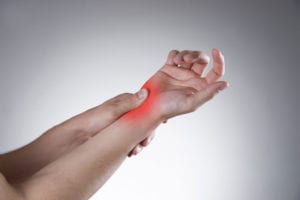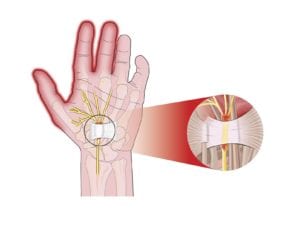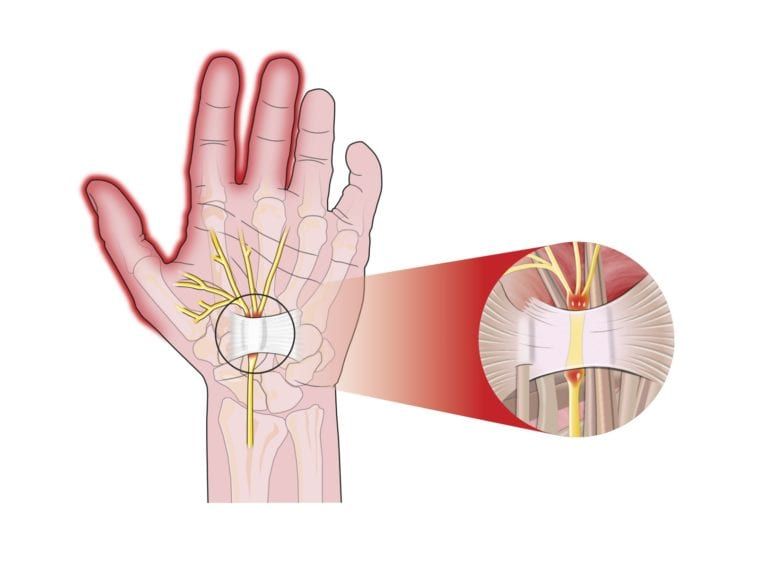
Background:
Carpal tunnel syndrome (CTS) is a medical condition in which the median nerve is compressed as it travels in the hand through the wrist at the carpal tunnel. It is the most common focal neuropathy. Prevalence rates for CTS are reported as 1-5% in the general population in the United States of America, with a higher occurrence in women.
Causes:
CTS is caused by increased pressure on the median nerve as it travels in the hand through the wrist. Compression of a peripheral nerve induces marked changes in the nerve fiber structure causing impairment and damage to the nerve. CTS can be associated with many medical conditions that cause pressure on the median nerve at the wrist, such as arthritis, pre-diabetes (impaired glucose tolerance), diabetes, thyroid dysfunction, trauma and possibly work-related.
Few studies also suggest that CTS is provoked by repetitive use of the hand and wrists in industrial occupation causing damage to the median nerve.
Signs and Symptoms:
 Numbness and tingling sensations in the fingers in the median nerve distribution are the hallmark neuropathic and compressive symptoms of carpal tunnel entrapment. Most often, the abnormal sensations are diverse and are confined to the thumb, index, middle finger and half of the ring finger, or any combination of those fingers, but should not include the palm of the hand.
Numbness and tingling sensations in the fingers in the median nerve distribution are the hallmark neuropathic and compressive symptoms of carpal tunnel entrapment. Most often, the abnormal sensations are diverse and are confined to the thumb, index, middle finger and half of the ring finger, or any combination of those fingers, but should not include the palm of the hand.
The numbness often is typically more noticeable at night, possibly related to awkward sleep position causing prolonged flexion of the wrist. Patients frequently awaken at night and shake their hands to relieve these symptoms. As symptoms progress, the pain may extend up towards the arm and it will be perceived as shoulder or forearm pain. CTS may progress to involve the motor fibers leading to difficulty using the fingers and weakness of hand grip.
Treatment Options:
Patients with signs and symptoms that correlate to CTS must have an electrodiagnostic study (Nerve conduction study and EMG) to confirm the diagnosis by a highly specialized and fellowship-trained neurologist as Dr Yono and Dr Kashouty. Ultrasound is also used to inspect the anatomy of the wrist at the carpal tunnel and to exclude other diseases.
Unless there is an urgent need for surgery, treatments such as wrist splints and corticosteroid injections are recommended initially to relieve the symptoms of CTS. Corticosteroids are a type of steroid medication, which are naturally produced hormones in the body. Carpal tunnel steroid injection has been shown in many research studies to relieve the symptoms of pain and tingling sensation, and is an effective treatment and may last up to one year. One injection is usually recommended to begin with. If the condition responds well to one injection but then recurs, the treatment may be repeated again. The benefit of using steroid injection is to lower the local inflammation in the wrist around the median nerve and also has powerful local anti-inflammatory agent to reduce the swelling and pain. These injections are done under ultrasound-guided in our clinic to improve accuracy of the procedure.
If conservative therapy fails to respond and relieve the symptoms, the decision to proceed to carpal tunnel release surgery should be considered. Typically carpal tunnel release surgery is indicated for finger weakness on clinical examination, persistent numbness and tingling in the fingers, or severe electrodiagnostic (Nerve conduction study and EMG) abnormalities.
Citation
Sandbrink, Friedhel M. “Median Neuropathy”: Background, Pathophysiology, Epidemiology. Medscape. Updated October 27, 2014. Accessed October 14, 2015.




